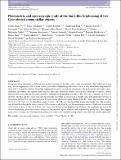Photometric and spectroscopic study of the burst-like brightening of two Gaia-alerted young stellar objects
Abstract
Young stars show variability on different time-scales from hours to decades, with a range of amplitudes. We studied two young stars, which triggered the Gaia Science Alerts system due to brightenings on a time-scale of a year. Gaia20bwa brightened by about half a magnitude, whereas Gaia20fgx brightened by about two and half magnitudes. We analysed the Gaia light curves, additional photometry, and spectra taken with the Telescopio Nazionale Galileo and the Gran Telescopio Canarias. Several emission lines were detected towards Gaia20bwa, including hydrogen lines from H α to H δ, Pa β, Br γ, and lines of Ca ii, O i, and Na i. The H α and Br γ lines were detected towards Gaia20fgx in emission in its bright state, with additional CO lines in absorption, and the Pa β line with an inverse P Cygni profile during its fading. Based on the Br γ lines, the accretion rate was (2.4-3.1) x 10-8M⊙ yr−1 for Gaia20bwa and (4.5-6.6) x 10-8M⊙ yr−1 for Gaia20fgx during their bright state. The accretion rate of Gaia20fgx dropped by almost a factor of 10 on a time-scale of half a year. The accretion parameters of both stars were found to be similar to those of classical T Tauri stars, lower than those of young eruptive stars. However, the amplitude and time-scale of these brightenings place these stars to a region of the parameter space, which is rarely populated by young stars. This suggests a new class of young stars, which produce outbursts on a time-scale similar to young eruptive stars, but with smaller amplitudes.
Citation
Nagy , Z , Ábrahám , P , Kóspál , Á , Park , S , Siwak , M , Cruz-Sáenz de Miera , F , Fiorellino , E , García-Álvarez , D , Szabó , Z M , Antoniucci , S , Giannini , T , Giunta , A , Kriskovics , L , Kun , M , Marton , G , Moór , A , Nisini , B , Pál , A , Szabados , L , Zieliński , P & Wyrzykowski , Ł 2022 , ' Photometric and spectroscopic study of the burst-like brightening of two Gaia -alerted young stellar objects ' , Monthly Notices of the Royal Astronomical Society , vol. 515 , no. 2 , pp. 1774-1787 . https://doi.org/10.1093/mnras/stac1915
Publication
Monthly Notices of the Royal Astronomical Society
Status
Peer reviewed
ISSN
0035-8711Type
Journal article
Description
Funding: This project has received funding from the European Research Council (ERC) under the European Union’s Horizon 2020 research and innovation programme under grant agreement no. 716155 (SACCRED). We acknowledge support from the ESA PRODEX contract no. 4000132054. GM acknowledges funding from the European Union’s Horizon 2020 research and innovation programme under grant agreement no. 101004141. PZ and LW acknowledges the support from European Commission’s H2020 OPTICON grant no. 730890, OPTICON RadioNet Pilot grant no. 101004719, as well as Polish NCN grant Daina no. 2017/27/L/ST9/03221. AP acknowledges support from grant K-138962 of the National Research, Development, and Innovation Office (NKFIH, Hungary). LK acknowledges the financial support of the Hungarian National Research, Development and Innovation Office grant NKFIH PD134784 and K-131508. LK is a Bolyai János Research Fellow. SA, TG, and BN received financial support from the project PRIN-INAF 2019 ‘Spectroscopically Tracing the Disk Dispersal Evolution’ and by the project PRIN-INAF-MAIN-STREAM 2017 ‘Protoplanetary discs seen through the eyes of new-generation instruments’.Collections
Items in the St Andrews Research Repository are protected by copyright, with all rights reserved, unless otherwise indicated.

